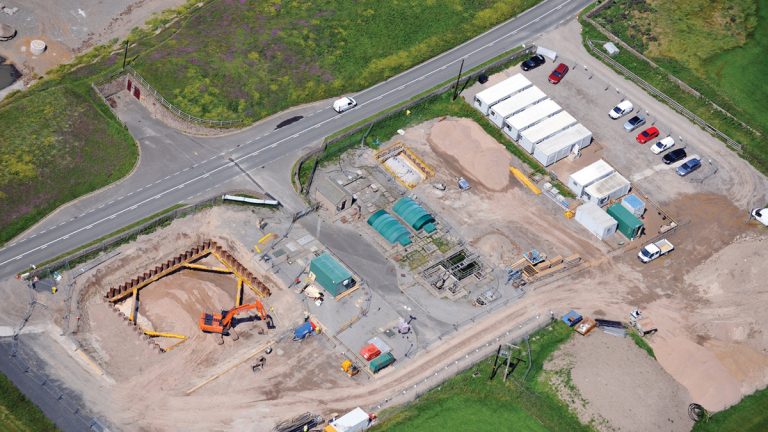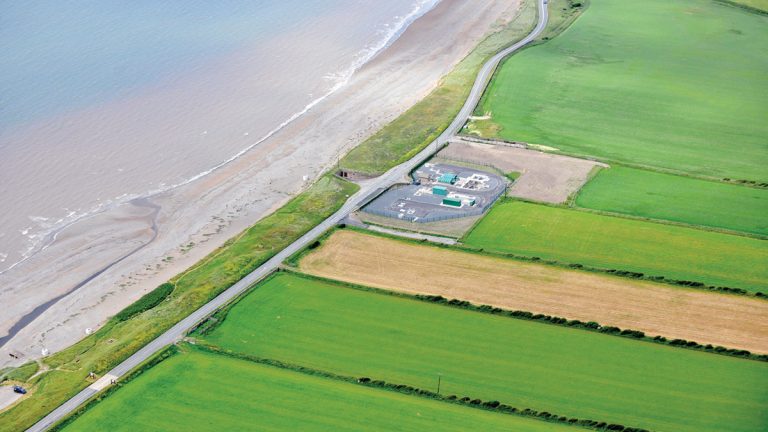Allonby WwTW (2017)

Completed works on site - Courtesy of C2V+
Allonby Wastewater Treatment Works (WwTW) is located to the north of the coastal town of Allonby, Cumbria, serving a population equivalent of less than 1000 within a dominantly rural catchment area. The works provides treatment via a three stage process, including rotating biological contactors (RBCs) and ultraviolet dosing. Allonby WwTW is situated on the coast and discharges into the Irish Sea via an existing dedicated long sea outfall. Expansion and improvement works to the site were identified by United Utilities to improve bathing water quality, to align with the Environment Agency targets for coastal waters and to accommodate future population growth. It was one of the first projects to be delivered under United Utilities’ AMP6 Construction Delivery Partner (CDP) framework and was completed by C2V+ in 2016.
Project scope
The primary aim of the project was to improve the effluent quality from Allonby WwTW and to reduce the frequency of unplanned discharges from the outfall, to comply with the Environment Agency quality drivers. For compliance with EC Bathing Waters this meant no more than one spill per five bathing seasons (May to September inclusive) and for compliance with Shellfish Waters, no more than 10 spills per annum. To achieve this, it was proposed that the existing WwTW was to be upgraded so that the amount of flow going through the full treatment process was doubled from 5 litres per second (l/s) to 10l/s. In addition, a significant expansion of the storm water storage capacity was proposed to reduce the number of storm spills to below the target levels.
The project was awarded to C2V+, a joint venture between CH2M and VolkerStevin, in March 2015, following a competitive tender as a design and build contract. The key elements of works comprised:
- Expansion of the existing works capacity through installation of additional process units, to provide full treatment to incoming flows of 10l/s.
- Improved ultraviolet treatment to reduce bacteriological levels within the effluent.
- Supplementation of existing works storage capacity to significantly increase the stormwater storage capacity of the site and reduce the frequency of unplanned spills from the outfall.
The existing works at Allonby WwTW provides fairly traditional treatment processes, comprising inlet screens and lift pump station, twin septic tank primary settlement units, twin rotating biological contactors (RBCs), ‘Dortmund’ type humus tanks, an ultraviolet dosing channel and a discharge tidal pumping station, with a tidal storage tank. There is no storm overflow at the site and all flows entering the works need to be discharged via the sea outfall.

Cofferdam installed for FtFT construction – Courtesy of C2V+
The outfall
Due to the location of the outfall, the works were only permitted to discharge during a fixed duration tidal window, either side of high tide. As such, the project needed to take into account the interaction of the tidal cycle with the storm events and ensure that sufficient on-site storage was provided, to reduce the number of spills from the outfall to less than one per bathing season and 10 per annum. Hence, whilst incoming flows did not generally exceed 35l/s, the outfall needed to be sized to discharge 80l/s to ensure both incoming and any stored flows could be discharged within the tidal window.
The catchment
It was identified at an early stage that the catchment was heavily impacted by surface water runoff. In addition, the main sewer pipe into the works was aged and identified as having significant defects. Due to its location near a water channel on the foreshore, it was believed to be allowing significant volumes of brackish water to enter the pipe system.
Not only was this adding additional unnecessary flow to the works, but it was also introducing sediment and the high salt content was of concern due to its potential negative impact on the works microbiological process units. Replacement of this section of pipeline was therefore considered critical to the successful operation of the works and prioritised as an early action.
Due to the nature of the catchment, dry weather flows were very low (<3l/s) and below the range of most pumps. To accommodate the flow to full treatment flow range, variable speed pumps were determined to be the most suitable equipment, operating within a range of approximately 4 to 10l/s. The wet well enabled incoming flows to be stored and passed forward in batches to provide practical delivery of dry weather flows whilst meeting the peak flow requirements.

Aerial view of works in progress – Courtesy of C2V+
The solution
It was determined that the additional treatment capacity should comprise new, similar process units installed in parallel with the existing. Process calculations confirmed that the existing RBCs were adequately sized to cater for the new design flows. Other process areas were expanded through supplementary units, which were identically sized to the existing where possible to ensure the level of process treatment and hydraulics were balanced across the units. The solution comprised the following key elements:
- Replacement of an approximately 300m section of pipeline on the main incoming sewer to ensure structural integrity and reduce infiltration into the pipe.
- Manholes were designed to accommodate variations in beach level through elevated top level and extended depth of concrete surround.
- New 6mm mechanical screen within the inlet works, installed within an existing building without top roof access, through component installation via the main access door (Haigh).
- New flow to full treatment (FtFT) pumping station fitted with variable speed pumps to cater for flow range of 4 to 10l/s. The wet well was provided with an enlarged storage capacity.
- New buried GRP septic tank unit and desludging line.
- New Dortmund type rectangular humus tank with new humus sludge return pumping station.
- New ultraviolet treatment plant comprising in-channel light units to treat the revised FtFT to reduce bacteriological levels to below consent standards (Trojan Technologies).
- New tidal pumping station equipped with two duty/standby variable speed pumps rated at 80l/s each and associated pipework.
- Diversion of site drainage into the FtFT wet well to operation of the sludge return pumping station.
- New flow distribution chambers.
- Installation of a new motor control centre (MCC) and automated control systems.

Works in progress – Courtesy of Courtesy of C2V+
The existing hydraulics and planning conditions required that the above ground structures were generally limited to small chambers and control buildings only. Hence, the new works, including the new septic tank, the humus tank and the large 16m x 9m x 6m deep dual pumping station and effluent storage tank were all designed and installed below ground with very little above ground impact. The need to enter below structures was minimised through the provision of access to mechanical components, controls and sensors from ground level. Safe access to the chambers was provided through planned working areas and access covers.
Construction of the works was successfully undertaken between 2015 and 2016, with the new works being commissioned for operation in March 2016. All completion targets were successfully achieved.
As the works needed to remain operational throughout the construction programme, the amount of offline construction was maximised with connections and tie-ins designed to be undertaken during short shutdown periods. Where possible, existing assets were re-used to optimise the efficiency of investment and avoid abandoned assets where possible.
The site for the new tidal storage area was constrained by the site boundary and required construction within a relatively small working area between existing tanks and services. This was achieved by the installation of a temporary sheet pile cofferdam. Significant dewatering of the excavation was required to control groundwater levels during the excavation.

Completed works – low above ground impact of new septic tank and humus tank – Courtesy of C2V+
Reductions to carbon footprint
Consideration of the project in its entirety included reduction of infiltration in the incoming flow, hydraulic planning of the outfall tidal system, to establish the size of the works as well as the storage capacity which was optimised to ensure environmental quality targets were met, whist avoiding over-sized and potentially under-utilised facilities being installed.
Space on site was constrained by the existing structures and the provision of storage capacity required the provision of deep tanks. Therefore, optimisation of the design was required to reduce the depth of tanks and the lift requirements of the pumping stations. In addition, waste was minimised through effective reuse and incorporation of the existing assets.
Summary
Working in cooperation with United Utilities, C2V+ has successfully delivered another important stage in the continued improvement of Cumbria’s beaches through the expansion and upgrade of the treatment works at Allonby.

Project completion aerial shot – Courtesy of C2V+
Following commissioning in 2016, the new works at Allonby is now operational, and is producing a significantly improved quality of effluent from the site. Relatively little is actually visible of the significant changes at Allonby WwTW and the site may appear relatively unchanged to the casual observer. However, the structures and pipework installed below ground have made a substantial improvement to the operation and capacity of the works such that it now meets the required quality standards and number of spills events and is delivering real benefits to both the community and the environment.







